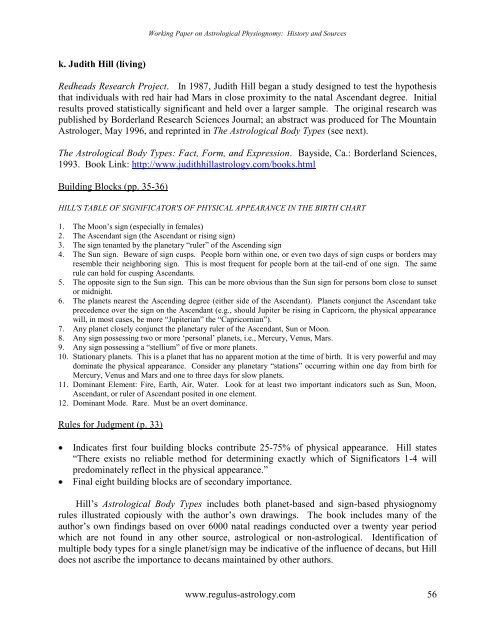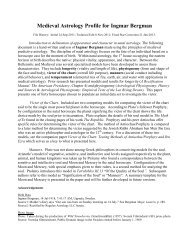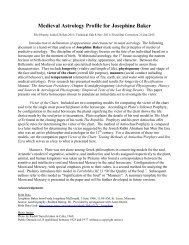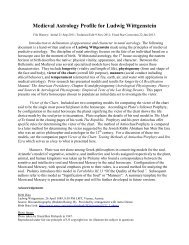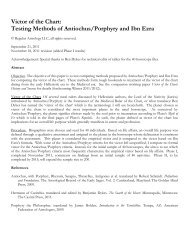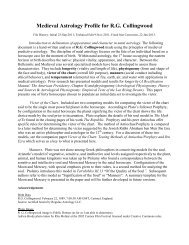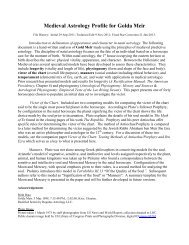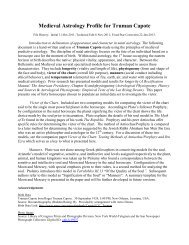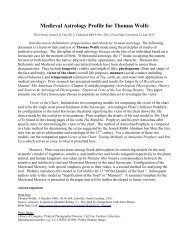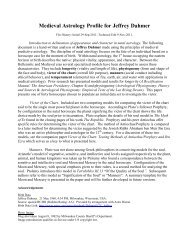Working Paper on Astrological Physiognomy: History and Sources
Working Paper on Astrological Physiognomy: History and Sources
Working Paper on Astrological Physiognomy: History and Sources
Create successful ePaper yourself
Turn your PDF publications into a flip-book with our unique Google optimized e-Paper software.
k. Judith Hill (living)<br />
<str<strong>on</strong>g>Working</str<strong>on</strong>g> <str<strong>on</strong>g>Paper</str<strong>on</strong>g> <strong>on</strong> <strong>Astrological</strong> <strong>Physiognomy</strong>: <strong>History</strong> <strong>and</strong> <strong>Sources</strong><br />
Redheads Research Project. In 1987, Judith Hill began a study designed to test the hypothesis<br />
that individuals with red hair had Mars in close proximity to the natal Ascendant degree. Initial<br />
results proved statistically significant <strong>and</strong> held over a larger sample. The original research was<br />
published by Borderl<strong>and</strong> Research Sciences Journal; an abstract was produced for The Mountain<br />
Astrologer, May 1996, <strong>and</strong> reprinted in The <strong>Astrological</strong> Body Types (see next).<br />
The <strong>Astrological</strong> Body Types: Fact, Form, <strong>and</strong> Expressi<strong>on</strong>. Bayside, Ca.: Borderl<strong>and</strong> Sciences,<br />
1993. Book Link: http://www.judithhillastrology.com/books.html<br />
Building Blocks (pp. 35-36)<br />
HILL'S TABLE OF SIGNIFICATOR'S OF PHYSICAL APPEARANCE IN THE BIRTH CHART<br />
1. The Mo<strong>on</strong>’s sign (especially in females)<br />
2. The Ascendant sign (the Ascendant or rising sign)<br />
3. The sign tenanted by the planetary “ruler” of the Ascending sign<br />
4. The Sun sign. Beware of sign cusps. People born within <strong>on</strong>e, or even two days of sign cusps or borders may<br />
resemble their neighboring sign. This is most frequent for people born at the tail-end of <strong>on</strong>e sign. The same<br />
rule can hold for cusping Ascendants.<br />
5. The opposite sign to the Sun sign. This can be more obvious than the Sun sign for pers<strong>on</strong>s born close to sunset<br />
or midnight.<br />
6. The planets nearest the Ascending degree (either side of the Ascendant). Planets c<strong>on</strong>junct the Ascendant take<br />
precedence over the sign <strong>on</strong> the Ascendant (e.g., should Jupiter be rising in Capricorn, the physical appearance<br />
will, in most cases, be more “Jupiterian” the “Capricornian”).<br />
7. Any planet closely c<strong>on</strong>junct the planetary ruler of the Ascendant, Sun or Mo<strong>on</strong>.<br />
8. Any sign possessing two or more ‘pers<strong>on</strong>al’ planets, i.e., Mercury, Venus, Mars.<br />
9. Any sign possessing a “stellium” of five or more planets.<br />
10. Stati<strong>on</strong>ary planets. This is a planet that has no apparent moti<strong>on</strong> at the time of birth. It is very powerful <strong>and</strong> may<br />
dominate the physical appearance. C<strong>on</strong>sider any planetary “stati<strong>on</strong>s” occurring within <strong>on</strong>e day from birth for<br />
Mercury, Venus <strong>and</strong> Mars <strong>and</strong> <strong>on</strong>e to three days for slow planets.<br />
11. Dominant Element: Fire, Earth, Air, Water. Look for at least two important indicators such as Sun, Mo<strong>on</strong>,<br />
Ascendant, or ruler of Ascendant posited in <strong>on</strong>e element.<br />
12. Dominant Mode. Rare. Must be an overt dominance.<br />
Rules for Judgment (p. 33)<br />
Indicates first four building blocks c<strong>on</strong>tribute 25-75% of physical appearance. Hill states<br />
“There exists no reliable method for determining exactly which of Significators 1-4 will<br />
predominately reflect in the physical appearance.”<br />
Final eight building blocks are of sec<strong>on</strong>dary importance.<br />
Hill’s <strong>Astrological</strong> Body Types includes both planet-based <strong>and</strong> sign-based physiognomy<br />
rules illustrated copiously with the author’s own drawings. The book includes many of the<br />
author’s own findings based <strong>on</strong> over 6000 natal readings c<strong>on</strong>ducted over a twenty year period<br />
which are not found in any other source, astrological or n<strong>on</strong>-astrological. Identificati<strong>on</strong> of<br />
multiple body types for a single planet/sign may be indicative of the influence of decans, but Hill<br />
does not ascribe the importance to decans maintained by other authors.<br />
www.regulus-astrology.com<br />
56


